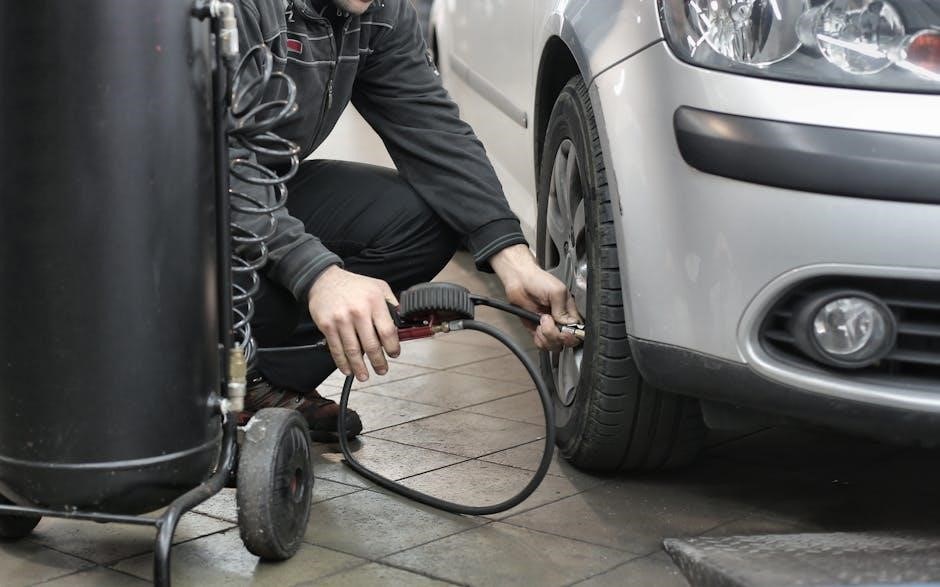Safety Guidelines
Always operate Porter-Cable air compressors on a maximum 50% duty cycle to prevent overheating and extend lifespan. Turn off the compressor and bleed pressure before maintenance or attaching tools. Read the manual thoroughly to understand safety precautions and operational limits. Avoid unsafe practices that could lead to injury or equipment damage. Wash hands after handling tools and ensure proper ventilation in the workspace.
1.1 Understanding Safety Labels and Symbols
Porter-Cable air compressors feature safety labels and symbols to alert users of potential hazards. These labels are color-coded and include text or images to convey critical information. Red labels indicate immediate dangers, such as explosion risks, while yellow labels highlight cautionary warnings, like hot surfaces or moving parts. Symbols, such as a hand cutting a wire, signify electrical warnings, while a fire symbol alerts users to flammable materials. A gear and hammer symbol denotes maintenance instructions. Always read and understand these labels before operating the compressor. Ignoring them can lead to serious injury or death. Familiarize yourself with the manual’s safety definitions, such as danger, warning, caution, and note, to ensure safe operation;

1.2 General Safety Precautions
Always read and understand the Porter-Cable air compressor manual before operation. Ensure the unit is turned off and pressure is bled from the tank and hose before performing maintenance or attaching tools. Operate the compressor in a well-ventilated area to avoid inhaling harmful fumes. Wear safety glasses and gloves to protect against flying debris or electrical hazards. Keep loose clothing and jewelry tied back to avoid entanglement with moving parts. Never allow children or untrained individuals to operate the compressor. Regularly inspect hoses, connections, and components for damage or wear. Follow manufacturer guidelines for compatible air tools and accessories. Properly ground the compressor to prevent electrical shock. Adhere to these precautions to ensure safe and efficient operation.
1.3 Hazardous Situations and Risk of Injury
Operating a Porter-Cable air compressor improperly can lead to hazardous situations, including explosion, fire, or severe injury. Exceeding the 50% duty cycle can cause overheating and damage to the compressor. Always bleed pressure from the tank and hose before maintenance to avoid sudden release of stored air, which can cause injury. Flying debris from faulty or damaged components poses a risk of eye or bodily harm. Improperly connected or worn-out hoses can lead to whipping hazards. Never modify or bypass safety features, as this can result in catastrophic failure. Risk of explosion exists if the air tank is not properly maintained or if excessive condensation is present. Follow all safety guidelines to minimize risks and ensure safe operation.

Product Description
Porter-Cable air compressors are reliable tools designed for various applications. They offer durable construction, efficient performance, and user-friendly controls. Available in multiple models to suit different needs.
2.1 Overview of Porter-Cable Air Compressors
Porter-Cable air compressors are known for their reliability and versatility, catering to both DIY enthusiasts and professionals. These compressors are designed to deliver consistent performance across various applications. With a focus on durability, Porter-Cable models feature robust steel tanks and efficient motors. The C2002 model, for instance, offers a 20-gallon tank capacity, making it suitable for demanding tasks. Their oil-free designs ensure low maintenance and reduced operational noise. Porter-Cable air compressors are widely recognized for their ease of use and durability, making them a popular choice for workshops and job sites. Whether for inflating tires or powering pneumatic tools, these compressors provide reliable service.
2.2 Key Components and Features
Porter-Cable air compressors are equipped with essential components designed for optimal performance. The units feature durable steel tanks, which store compressed air efficiently, and powerful induction motors for reliable startups. The air compressors include pressure gauges for monitoring tank pressure and regulator knobs for precise airflow control. Additional features like quick-connect couplers enable easy attachment of air hoses and tools. Some models also incorporate thermal overload protection to prevent motor damage. These components and features ensure smooth operation, making Porter-Cable air compressors suitable for a variety of applications, from light-duty tasks to heavy-duty industrial use. Their design emphasizes both functionality and user convenience.
2.3 Technical Specifications
Porter-Cable air compressors are built with high-quality components and advanced engineering. They feature robust steel tanks with capacities ranging from 6 to 20 gallons, ensuring ample air storage for various tasks. Equipped with powerful induction motors, these compressors deliver reliable startups and consistent performance. The maximum pressure rating typically reaches 150 PSI, providing sufficient power for demanding applications. Airflow rates vary by model, with common CFM ratings at 90 PSI ranging from 4 to 7 CFM. Designed for efficiency, most models operate on a 50% duty cycle, balancing productivity and motor longevity. Additional features include built-in pressure gauges, regulator controls, and quick-connect ports for seamless tool integration. These specifications make Porter-Cable compressors versatile tools for both professionals and DIY enthusiasts.


Installation and Setup
Properly unpack and inspect the compressor for damage. Choose a well-ventilated, level surface away from flammable materials. Connect to a suitable power source, ensuring compliance with voltage requirements. Follow manual instructions for initial setup and testing to ensure safe and efficient operation. Always bleed pressure before starting any maintenance or adjustments. Consult the manual for specific installation guidelines tailored to your model.
3.1 Unpacking and Inspecting the Compressor
Carefully unpack the Porter-Cable air compressor, ensuring all components are included and undamaged. Inspect for any signs of shipping damage, such as dents or leaks. Verify the compressor, air tank, and accessories match the manual’s specifications; Check for loose connections or fittings that may have come undone during transit. Tighten any loose parts according to the manual’s instructions. If damage is found, contact Porter-Cable customer support immediately. Always follow the manual’s guidelines for initial inspection to ensure safe and proper operation. Proper inspection helps prevent future issues and ensures optimal performance. Refer to the manual for specific model-related checks and procedures.
3.2 Choosing the Right Location for Installation
Select a well-ventilated, dry, and level surface for your Porter-Cable air compressor. Ensure the area is free from flammable materials and away from direct sunlight. Avoid damp or humid environments to prevent rust and electrical issues. The location should be easily accessible for maintenance and operation. Keep the compressor at least 3 feet away from any walls or obstructions to allow proper airflow. Ensure the floor is sturdy enough to support the unit’s weight. Avoid placing the compressor near open windows or doors to minimize dust and debris intake. Proper placement enhances safety, efficiency, and longevity of the equipment. Always refer to the manual for specific location recommendations tailored to your model.
3.3 Electrical Connection and Power Requirements
Ensure the Porter-Cable air compressor is connected to a dedicated electrical circuit that matches the unit’s voltage and amperage requirements, as specified in the manual. Avoid using extension cords, as they may cause voltage drops and affect performance. Verify that the circuit is properly grounded to prevent electrical hazards. Check the compressor’s nameplate for exact power specifications and ensure your electrical supply meets these requirements. Turn off the main power supply before performing any electrical connections. Consult a licensed electrician if unsure about wiring or compatibility. Always follow local electrical codes and safety standards. Proper electrical setup ensures safe and efficient operation of the compressor. Refer to the manual for detailed instructions tailored to your model.
3.4 Initial Setup and Testing
After unpacking and installing, inspect the Porter-Cable air compressor for any damage or leaks. Ensure all components are securely connected. Before initial startup, check the oil level if applicable and ensure the tank is drained of condensation. Plug in the unit and set the pressure regulator to the minimum setting. Turn on the compressor and allow it to build pressure gradually. Monitor the gauges and listen for unusual noises. Once the tank reaches the recommended pressure, test the air flow by attaching a hose and checking for leaks. Refer to the manual for specific instructions on bleed valves and pressure settings. This process ensures the compressor operates smoothly and efficiently from the start. Always follow safety guidelines during testing to prevent accidents.

Operating the Compressor
Start the compressor and monitor the pressure gauge to ensure it operates within the recommended range. Use air tools safely, adhering to the 50% duty cycle limit. Always shut down properly after use.
4.1 Starting the Compressor for the First Time
Before starting, read the manual thoroughly and ensure all safety guidelines are understood. Inspect the compressor for any damage or leaks. Ensure the tank is empty and the drain valve is closed. Check the power cord and plug for damage and plug it into a suitable outlet. Turn the compressor on and allow it to build pressure gradually. Monitor the pressure gauge to ensure it does not exceed the recommended level. Once the tank is fully pressurized, turn off the compressor and allow it to cool slightly before use. Always bleed pressure from the tank and hoses before performing maintenance or attaching tools. This ensures a safe and efficient first-time operation.
4.2 Understanding Duty Cycle and Operation Limits
Porter-Cable air compressors are designed to operate within specific limits to ensure reliability and longevity. The duty cycle refers to the percentage of time the compressor can run compared to its rest period. For most Porter-Cable models, the maximum recommended duty cycle is 50%, meaning the compressor should not operate continuously for more than 50% of any given hour. Exceeding this limit can lead to overheating and premature wear. Always monitor the compressor’s workload and ensure it operates within the specified pressure range, typically up to 150 PSI. Avoid running the compressor for extended periods without allowing it to cool down. Adhering to these operation limits ensures safe and efficient performance while extending the lifespan of the unit. Regular maintenance, such as draining condensation, also supports optimal operation.
4.3 Monitoring Pressure and Adjusting Settings
Proper pressure monitoring is crucial for efficient operation of your Porter-Cable air compressor. The unit is equipped with a pressure gauge that displays the current tank pressure. Always ensure the pressure does not exceed the maximum recommended level, typically 150 PSI. Adjust the regulator to match the requirements of your air tools, ensuring optimal performance without wasting energy. Regularly check for leaks in hoses and connections, as they can cause pressure drops. If the compressor frequently cycles on and off, it may indicate improper settings or excessive demand. Refer to the user manual for specific guidelines on adjusting pressure settings and maintaining stable operation. Proper monitoring prevents overloading and extends the compressor’s lifespan.
4.4 Attaching and Using Air Tools
To ensure safe and efficient operation, always attach air tools correctly to your Porter-Cable air compressor. Verify that the tool is compatible with the compressor’s specifications, as outlined in the user manual. Connect the air hose securely to both the compressor and the tool, ensuring no leaks. Before use, check the hose and connections for damage or wear. Turn on the compressor and allow it to reach the recommended pressure. Operate the tool according to its design and the manual’s instructions. Never exceed the tool’s maximum pressure rating. After use, turn off the compressor, bleed the tank, and disconnect the tool to prevent residual pressure. Always follow safety guidelines to avoid accidents and maintain optimal performance. Regularly inspect tools and hoses for damage to ensure reliable operation.

Maintenance and Care
Regularly drain moisture from the tank to prevent rust and damage. Check hoses and connections for wear. Follow manual guidelines for routine inspections and part replacements.
Regular maintenance ensures optimal performance and longevity of your Porter-Cable air compressor. Daily, inspect the air filter and clean or replace it as needed to maintain airflow. Check the oil level if your model requires it, and top it off with the recommended grade. Weekly, drain condensation from the tank to prevent rust and internal damage. Inspect hoses and connections for signs of wear, cracks, or leaks, and replace them if necessary. Monthly, examine the compressor’s belts for alignment and tension, adjusting or replacing them as needed. Always refer to the user manual for specific maintenance schedules and procedures tailored to your model. Regular lubrication of moving parts can also prevent friction-related issues. By following these routine tasks, you can ensure reliable operation and minimize the risk of unexpected breakdowns. Regularly draining moisture and condensation is crucial for maintaining your Porter-Cable air compressor. Condensation accumulates in the tank due to humidity and temperature changes, leading to rust and internal damage if not removed. To drain, turn off the compressor and allow it to cool. Locate the drain valve, typically at the bottom of the tank, and open it to release accumulated water. Use a bucket or pan to collect the liquid. For models with automatic drain systems, ensure they are functioning correctly. If manual draining is required, do this daily or after each use, especially in high-humidity environments. Always refer to the user manual for specific instructions on draining procedures for your compressor model. Regular draining prevents corrosion and ensures efficient operation. Identify and resolve common issues with your Porter-Cable air compressor to ensure optimal performance. If the compressor fails to start, check the power supply, circuit breaker, or fuses. Low pressure output may indicate air leaks in hoses or improper regulator settings. If the motor overheats, ensure proper ventilation and check for blocked air vents. Condensation buildup can cause operational issues, so regular draining is essential. For abnormal noises, inspect belts for alignment or wear. If the compressor shuts off unexpectedly, verify the pressure switch settings. Always refer to the user manual for specific troubleshooting steps tailored to your model. Addressing these issues promptly prevents further damage and extends the compressor’s lifespan. Regular maintenance can help minimize these problems. Replace worn or damaged parts promptly to maintain your Porter-Cable air compressor’s performance. Always use genuine Porter-Cable accessories to ensure compatibility and safety. Check the warranty for covered replacements. For parts not under warranty, purchase from authorized dealers. Regularly inspect and replace air filters, hoses, and belts to prevent operational issues. Before replacing any component, turn off the power and bleed pressure from the tank. Refer to the user manual for specific instructions on disassembling and reassembling parts. If unsure, contact Porter-Cable customer support for guidance. Keep a record of replaced parts for future reference. Proper replacement ensures optimal functionality and extends the compressor’s lifespan. Always follow safety guidelines during maintenance. Porter-Cable air compressors support a variety of compatible air tools, hoses, and attachments. Choose accessories that match your compressor’s specifications for optimal performance and safety. Porter-Cable air compressors are designed to work seamlessly with a wide range of pneumatic tools and accessories. Ensure all tools and attachments are compatible with your compressor’s specifications, such as pressure and flow rate. Common compatible tools include impact wrenches, nailers, and spray guns. Always check the tool’s requirements against the compressor’s output to avoid damage or inefficient operation. Use genuine Porter-Cable accessories for optimal performance and safety. Properly sized air hoses and fittings are essential for maintaining consistent pressure and minimizing leaks. Refer to the manual for specific recommendations on tools and accessories. This ensures your setup operates efficiently and adheres to safety standards. Proper installation and use of air hoses are crucial for safe and efficient operation. Choose hoses with ratings matching your compressor’s maximum pressure and flow rate. Before connecting, inspect hoses for damage or wear; Attach the hose securely to both the compressor and tool to prevent leaks. Ensure proper routing to avoid kinks or pinching, which can restrict airflow. Regularly inspect hoses for signs of wear, such as cracks or abrasions, and replace them if necessary. Always depressurize the system before disconnecting hoses. Follow the manufacturer’s guidelines for optimal performance and safety. Proper maintenance of air hoses ensures reliable operation and extends equipment lifespan. Porter-Cable air compressors offer various additional features and upgrade options to enhance performance and versatility. These include advanced filtration systems to reduce moisture and contaminants, ensuring cleaner air flow for tools. Upgraded pressure gauges provide precise monitoring, while optional dual-control panels allow for easier operation. Noise reduction kits can be installed to minimize operational sound levels. Accessories like extended hoses, high-capacity air tanks, and specialized tool attachments are also available. Upgrades should be installed according to the manufacturer’s guidelines to maintain warranty coverage and ensure compatibility. These enhancements can improve efficiency, reduce downtime, and extend the lifespan of your compressor system. Always refer to the user manual or contact Porter-Cable support for authorized upgrades. Porter-Cable provides comprehensive technical support through their official website, including downloadable manuals, troubleshooting guides, and warranty information. Users can access resources via the SERVICENET portal. Porter-Cable air compressors are backed by a limited warranty that covers defects in materials and workmanship. The pneumatic tools are typically covered for 2 years, while the compressor unit and tank may have a 1-year warranty. Specific terms and conditions are outlined in the product manual or on the manufacturer’s website. To ensure warranty coverage, users must operate the compressor according to the provided instructions and maintain proper records. Warranty claims require proof of purchase and may involve contacting Porter-Cable’s customer support team. The warranty does not cover damage resulting from misuse, neglect, or unauthorized modifications. Always review the warranty section in the manual for detailed information on what is covered and how to file a claim. Proper usage and registration can enhance warranty benefits. For assistance with Porter-Cable air compressors, customers can contact the dedicated support team through various channels. Visit the official Porter-Cable website to access the SERVICENET portal, where you can find service locations, manuals, and troubleshooting resources. Telephone support is available during business hours for immediate inquiries. Additionally, email support allows users to submit detailed questions or concerns. When reaching out, have the product model number and serial number ready to expedite service. Porter-Cable also provides a comprehensive FAQ section online to address common issues. Their team is trained to help with warranty claims, maintenance advice, and technical support, ensuring optimal performance and longevity of your air compressor. Timely support is crucial for resolving issues quickly. Porter-Cable provides comprehensive online resources to support air compressor users. The SERVICENET portal allows customers to view and download owner’s manuals, service manuals, and troubleshooting guides. Users can access these resources by visiting the Porter-Cable website and entering their product’s model number. Additionally, the website offers FAQs, warranty information, and maintenance tips to ensure optimal performance. For convenience, all manuals are available in PDF format for easy viewing or printing. Online resources are regularly updated to reflect the latest product information and technical advancements. Utilizing these resources helps users resolve issues quickly and maintain their air compressors effectively. This ensures a seamless experience for both professionals and DIY enthusiasts. Properly following the manual ensures safe and efficient operation of your Porter-Cable air compressor. Always adhere to safety guidelines and maintenance recommendations for optimal performance. The Porter-Cable air compressor user manual emphasizes safety, proper operation, and maintenance. Always read the manual before use to understand safety guidelines and operational limits. The compressor should not exceed a 50% duty cycle to prevent overheating and prolong its lifespan. Regular maintenance, such as draining moisture and checking for leaks, is crucial for optimal performance. Troubleshooting common issues and replacing parts as needed ensures reliability. Familiarize yourself with compatible tools and accessories for efficient use. Refer to the manual for warranty details and technical support resources. Proper care and adherence to instructions will maximize the compressor’s efficiency and longevity, ensuring safe and effective operation. Always prioritize safety when operating the Porter-Cable air compressor. Ensure the compressor is turned off and pressure is released before performing any maintenance or attaching tools. Regularly inspect hoses and connections for leaks or damage to prevent accidents. Operate the compressor in a well-ventilated area to avoid inhaling harmful fumes. Never exceed the recommended duty cycle to prevent overheating and potential damage. Follow all safety guidelines outlined in the manual to minimize the risk of injury or equipment failure. Keep loose clothing and long hair tied back while working with pneumatic tools. Store the compressor in a dry, secure location out of reach of children. Adhering to these safety reminders ensures safe and efficient operation of your Porter-Cable air compressor.5.1 Routine Maintenance Tasks
5.2 Draining Moisture and Condensation
5.3 Troubleshooting Common Issues
5.4 Replacing Parts and Accessories

Accessories and Attachments
6.1 Compatible Air Tools and Accessories
6.2 Installing and Using Air Hoses
6.3 Additional Features and Upgrades

Technical Support and Resources
7.1 Warranty Information and Coverage
7.2 Contacting Porter-Cable Customer Support
7.3 Online Resources and Manuals

8.1 Summary of Key Points
8.2 Final Safety Reminders


